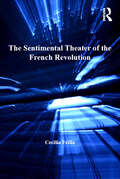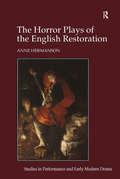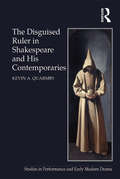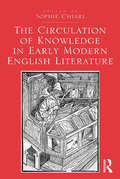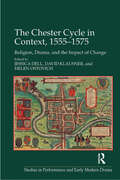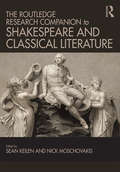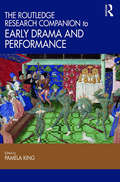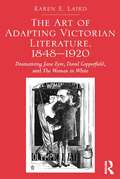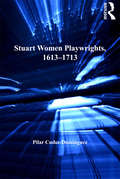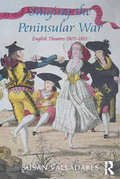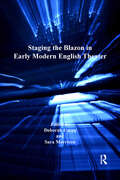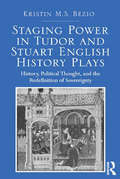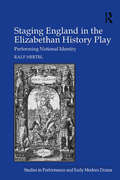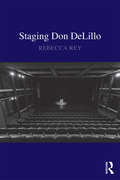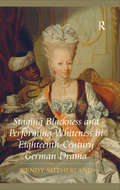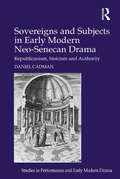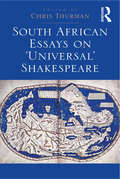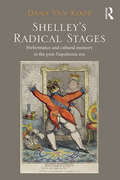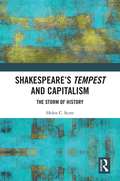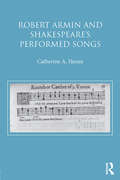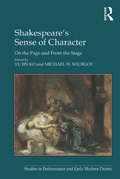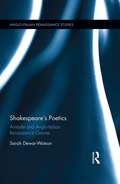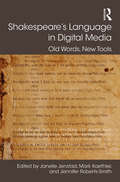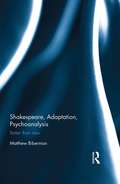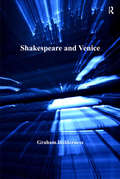- Table View
- List View
The Sentimental Theater of the French Revolution (Performance In The Long Eighteenth Century: Studies In Theatre, Music, Dance Ser.)
by Cecilia FeillaSmoothly blending performance theory, literary analysis, and historical insights, Cecilia Feilla explores the mutually dependent discourses of feeling and politics and their impact on the theatre and theatre audiences during the French Revolution. Remarkably, the most frequently performed and popular plays from 1789 to 1799 were not the political action pieces that have been the subject of much literary and historical criticism, but rather sentimental dramas and comedies, many of which originated on the stages of the Old Regime. Feilla suggests that theatre provided an important bridge from affective communities of sentimentality to active political communities of the nation, arguing that the performance of virtue on stage served to foster the passage from private emotion to public virtue and allowed groups such as women, children, and the poor who were excluded from direct political participation to imagine a new and inclusive social and political structure. Providing close readings of texts by, among others, Denis Diderot, Collot d'Herbois, and Voltaire, Feilla maps the ways in which continuities and innovations in the theatre from 1760 to 1800 set the stage for the nineteenth century. Her book revitalizes and enriches our understanding of the significance of sentimental drama, showing that it was central to the way that drama both shaped and was shaped by political culture.
The Horror Plays of the English Restoration (Studies in Performance and Early Modern Drama)
by Anne HermansonA decade after the Restoration of Charles II, a disturbing group of tragedies, dubbed by modern critics the horror or the blood-and-torture villain tragedies, burst onto the London stage. Ten years later they were gone - absorbed into the partisan frenzy which enveloped the theatre at the height of the Exclusion Crisis. Despite burgeoning interest, until now there has been no full investigation into why these deeply unsettling plays were written when they were and why they so fascinated audiences for the period that they held the stage. The author’s contention is that the genre of horror gains its popularity at times of social dislocation. It reflects deep schisms in society, and English society was profoundly unsettled and in a (delayed) state of shock from years of social upheaval and civil conflict. Through recurrent images of monstrosity, madness, venereal disease, incest and atheism, Hermanson argues that the horror dramatists trope deep-seated and unresolved anxieties - engaging profoundly with contemporary discourse by abreacting the conspiratorial climate of suspicion and fear. Some go as far as to question unequivocally the moral and political value of monarchy, vilifying the office of kingship and pushing ideas of atheism further than in any drama produced since Seneca. This study marks the first comprehensive investigation of these macabre tragedies in which playwrights such as Nathaniel Lee, Thomas Shadwell, Elkanah Settle, Thomas Otway and the Earl of Rochester take their audience on an exploration of human iniquity, thrusting them into an examination of man’s relationship to God, power, justice and evil.
The Disguised Ruler in Shakespeare and his Contemporaries (Studies in Performance and Early Modern Drama)
by Kevin A. QuarmbyIn the early seventeenth century, the London stage often portrayed a ruler covertly spying on his subjects. Traditionally deemed 'Jacobean disguised ruler plays', these works include Shakespeare's Measure for Measure, Marston's The Malcontent and The Fawn, Middleton's The Phoenix, and Sharpham's The Fleer. Commonly dated to the arrival of James I, these plays are typically viewed as synchronic commentaries on the Jacobean regime. Kevin A. Quarmby demonstrates that the disguised ruler motif actually evolved in the 1580s. It emerged from medieval folklore and balladry, Tudor Chronicle history and European tragicomedy. Familiar on the Elizabethan stage, these incognito rulers initially offered light-hearted, romantic entertainment, only to suffer a sinister transformation as England awaited its ageing queen's demise. The disguised royal had become a dangerously voyeuristic political entity by the time James assumed the throne. Traditional critical perspectives also disregard contemporary theatrical competition. Market demands shaped the repertories. Rivalry among playing companies guaranteed the motif's ongoing vitality. The disguised ruler's presence in a play reassured audiences; it also facilitated a subversive exploration of contemporary social and political issues. Gradually, the disguised ruler's dramatic currency faded, but the figure remained vibrant as an object of parody until the playhouses closed in the 1640s.
The Circulation of Knowledge in Early Modern English Literature
by Sophie ChiariWith its many rites of initiation (religious, educational, professional or sexual), Elizabethan and Jacobean education emphasized both imitation and discovery in a struggle to bring population to a minimal literacy, while more demanding techniques were being developed for the cultural elite. The Circulation of Knowledge in Early Modern English Literature examines the question of transmission and of the educational procedures in16th- and 17th-century England by emphasizing deviant practices that questioned, reassessed or even challenged pre-established cultural norms and traditions. This volume thus alternates theoretical analyses with more specific readings in order to investigate the multiple ways in which ideas then circulated. It also addresses the ways in which the dominant cultural forms of the literature and drama of Shakespeare’s age were being subverted. In this regard, its various contributors analyze how the interrelated processes of initiation, transmission and transgression operated at the core of early modern English culture, and how Christopher Marlowe, William Shakespeare and Thomas Middleton, or lesser known poets and playwrights such as Thomas Howell, Thomas Edwards and George Villiers, managed to appropriate these cultural processes in their works.
The Chester Cycle in Context, 1555-1575: Religion, Drama, and the Impact of Change (Studies in Performance and Early Modern Drama)
by Jessica Dell David KlausnerThe Chester Cycle in Context, 1555-1575 considers the implications of recent archival research which has profoundly changed our view of the continuation of performances of Chester's civic biblical play cycle into the reign of Elizabeth I. Scholars now view the decline and ultimate abandonment of civic religious drama as the result of a complex network of local pressures, heavily dependent upon individual civic and ecclesiastical authorities, rather than a result of a nation-wide policy of suppression, as had previously been assumed.
The Routledge Research Companion to Shakespeare and Classical Literature
by Nick Moschovakis Sean KeilenIn this wide-ranging and ambitiously conceived Research Companion, contributors explore Shakespeare’s relationship to the classic in two broad senses. The essays analyze Shakespeare’s specific debts to classical works and weigh his classicism’s likeness and unlikeness to that of others in his time; they also evaluate the effects of that classical influence to assess the extent to which it is connected with whatever qualities still make Shakespeare, himself, a classic (arguably the classic) of modern world literature and drama. The first sense of the classic which the volume addresses is the classical culture of Latin and Greek reading, translation, and imitation. Education in the canon of pagan classics bound Shakespeare together with other writers in what was the dominant tradition of English and European poetry and drama, up through the nineteenth and even well into the twentieth century. Second—and no less central—is the idea of classics as such, that of books whose perceived value, exceeding that of most in their era, justifies their protection against historical and cultural change. The volume’s organizing insight is that as Shakespeare was made a classic in this second, antiquarian sense, his work’s reception has more and more come to resemble that of classics in the first sense—of ancient texts subject to labored critical study by masses of professional interpreters who are needed to mediate their meaning, simply because of the texts’ growing remoteness from ordinary life, language, and consciousness. The volume presents overviews and argumentative essays about the presence of Latin and Greek literature in Shakespeare’s writing. They coexist in the volume with thought pieces on the uses of the classical as a historical and pedagogical category, and with practical essays on the place of ancient classics in today’s Shakespearean classrooms.
The Routledge Research Companion to Early Drama and Performance (Routledge Companions)
by Pamela KingThe study of early drama has undergone a quiet revolution in the last four decades, radically altering critical approaches to form, genre, and canon. Drawing on disciplines from art history to musicology and reception studies, The Routledge Research Companion to Early Drama and Performance reconsiders early "drama" as a mixed mode entertainment best studied not only alongside non-dramatic texts, but also other modes of performance. From performance before the playhouse to the afterlife of medieval drama in the contemporary avant-garde, this stunning collection of essays is divided into four sections: Northern European Playing before the Playhouse; Modes of Production and Reception; Reviewing the Anglophone Tradition; The Long Middle Ages Offering a much needed reassessment of what is generally understood as "English medieval drama", The Routledge Research Companion to Early Drama and Performance provides an invaluable resource for both students and scholars of medieval studies.
The Art of Adapting Victorian Literature, 1848-1920: Dramatizing Jane Eyre, David Copperfield, and The Woman in White
by Karen E. LairdIn The Art of Adapting Victorian Literature, 1848-1920, Karen E. Laird alternates between readings of nineteenth-century stage and twentieth-century silent film adaptations to investigate the working practices of the first adapters of Victorian fiction. Laird’s juxtaposition between stage and screen brings to life the dynamic culture of literary adaptation as it developed throughout the long nineteenth-century. Focusing on Charlotte Brontë’s Jane Eyre, Charles Dickens’s David Copperfield, and Wilkie Collins’s The Woman in White, Laird demonstrates how adaptations performed the valuable cultural work of expanding the original novel’s readership across class and gender divides, exporting the English novel to America, and commemorating the novelists through adaptations that functioned as virtual literary tourism. Bridging the divide between literary criticism, film studies, and theatre history, Laird’s book reveals how the Victorian adapters set the stage for our contemporary film adaptation industry.
Stuart Women Playwrights, 1613–1713
by Pilar Cuder-DominguezIn the field of seventeenth-century English drama, women participated not only as spectators or readers, but more and more as patronesses, as playwrights, and later on as actresses and even as managers. This study examines English women writers' tragedies and tragicomedies in the seventeenth century, specifically between 1613 and 1713, which represent the publication dates of the first original tragedy (Elizabeth Cary's The Tragedy of Mariam) and the last one (Anne Finch's Aristomenes) written by a Stuart woman playwright. Through this one-hundred year period, major changes in dramatic form and ideology are traced in women's tragedies and tragicomedies. In examining the whole of the century from a gender perspective, this project breaks away from conventional approaches to the subject, which tend to establish an unbridgeable gap between the early Stuart period and the Restoration. All in all, this study represents a major overhaul of current theories of the evolution of English drama as well as offering an unprecedented reconstruction of the genealogy of seventeenth-century English women playwrights.
Staging the Peninsular War: English Theatres 1807-1815
by Susan ValladaresFrom Napoleon's invasion of Portugal in 1807 to his final defeat at Waterloo, the English theatres played a crucial role in the mediation of the Peninsular campaign. In the first in-depth study of English theatre during the Peninsular War, Susan Valladares contextualizes the theatrical treatment of the war within the larger political and ideological axes of Romantic performance. Exploring the role of spectacle in the mediation of war and the links between theatrical productions and print culture, she argues that the popularity of theatre-going and the improvisation and topicality unique to dramatic performance make the theatre an ideal lens for studying the construction of the Peninsular War in the public domain. Without simplifying the complex issues involved in the study of citizenship, communal identities, and ideological investments, Valladares recovers a wartime theatre that helped celebrate military engagements, reform political sympathies, and register the public’s complex relationship with Britain’s military campaign in the Iberian Peninsula. From its nuanced reading of Richard Brinsley Sheridan's Pizarro (1799), to its accounts of wartime productions of Shakespeare, description of performances at the minor theatres, and detailed case study of dramatic culture in Bristol, Valladares’s book reveals how theatrical entertainments reflected and helped shape public feeling on the Peninsular campaign.
Staging the Blazon in Early Modern English Theater (Studies In Performance And Early Modern Drama)
by Sara Morrison Deborah UmanOffering the first sustained and comprehensive scholarly consideration of the dramatic potential of the blazon, this volume complicates what has become a standard reading of the Petrarchan convention of dismembering the beloved through poetic description. At the same time, it contributes to a growing understanding of the relationship between the material conditions of theater and interpretations of plays by Shakespeare and his contemporaries. The chapters in this collection are organized into five thematic parts emphasizing the conventions of theater that compel us to consider bodies as both literally present and figuratively represented through languge. The first part addresses the dramatic blazon as used within the conventions of courtly love. Examining the classical roots of the Petrarchan blazon, the next part explores the violent eroticism of a poetic technique rooted in Ovidian notions of metamorphosis. With similar attention paid to brutality, the third part analyzes the representation of blazonic dismemberment on stage and screen. Figurative battles become real in the fourth part, which addresses the frequent blazons surfacing in historical and political plays. The final part moves to the role of audience, analyzing the role of the observer in containing the identity of the blazoned woman as well as her attempts to resist becoming an objectified spectacle.
Staging Power in Tudor and Stuart English History Plays: History, Political Thought, and the Redefinition of Sovereignty
by Kristin M.S. BezioStaging Power in Tudor and Stuart English History Plays examines the changing ideological conceptions of sovereignty and their on-stage representations in the public theaters during the Elizabethan and early Stuart periods (1580-1642). The study examines the way in which the early modern stage presented a critical dialogue concerning the nature of sovereignty through the lens of specifically English history, focusing in particular on the presentation and representation of monarchy. It presents the subgenre of the English history play as a specific reaction to the surrounding political context capable of engaging with and influencing popular and elite conceptions of monarchy and government. This project is the first of its kind to specifically situate the early modern debate on sovereignty within a 'popular culture' dramatic context; its purpose is not only to provide an historical timeline of English political theory pertaining to monarchy, but to situate the drama as a significant influence on the production and dissemination thereof during the Tudor and Stuart periods. Some of the plays considered here, notably those by Shakespeare and Marlowe, have been extensively and thoroughly studied. But others-such as Edmund Ironside, Sir Thomas Wyatt, and King John and Matilda-have not previously been the focus of much critical attention.
Staging England in the Elizabethan History Play: Performing National Identity (Studies In Performance And Early Modern Drama Ser.)
by Ralf HertelApplying current political theory on nationhood as well as methods established by recent performance studies, this study sheds new light on the role the public theatre played in the rise of English national identity around 1600. It situates selected history plays by Shakespeare and Marlowe in the context of non-fictional texts (such as historiographies, chorographies, political treatises, or dictionary entries) and cultural artefacts (such as maps or portraits), and thus highlights the circulation, and mutation, of national thought in late sixteenth-century culture. At the same time, it goes beyond a New Historicist approach by foregrounding the performative surplus of the theatre event that is so essential for the shaping of collective identity. How, this study crucially asks, does the performative art of theatre contribute to the dynamics of the formation of national identity? Although theories about the nature of nationalism vary, a majority of theorists agree that notions of a shared territory and history, as well as questions of religion, class and gender play crucial roles in the shaping of national identity. These factors inform the structure of this book, and each is examined individually. In contrast to existing publications, this inquiry does not take for granted a pre-existing national identity that simply manifested itself in the literary works of the period; nor does it proceed from preconceived notions of the playwrights’ political views. Instead, it understands the early modern stage as an essentially contested space in which conflicting political positions are played off against each other, and it inquires into how the imaginative work of negotiating these stances eventually contributed to a rising national self-awareness in the spectators.
Staging Don DeLillo
by Rebecca ReyThe first book-length study to focus on Don DeLillo's plays, Staging Don DeLillo brings the author's theatre works to the forefront. Rebecca Rey explores four central themes that emerge across DeLillo's theatre oeuvre: the centrality of language; the human fear of death; the elusiveness of truth; and the deceptive, slippery nature of personal identity. Rey examines all seven of DeLillo's plays chronologically: "The Engineer of Moonlight" (1979), The Day Room (1986), the one-minute plays "The Rapture of the Athlete Assumed Into Heaven" (1990), and "The Mystery at the Middle of Ordinary Life" (2000), Valparaiso (1999), Love-Lies-Bleeding (2006), and The Word for Snow (2014). Written in clear, accessible language, and interweaving critique of DeLillo's novels throughout, this book will appeal not only to DeLillo scholars but also to anyone working on contemporary literature and drama.
Staging Blackness and Performing Whiteness in Eighteenth-Century German Drama (Ashgate New Critical Thinking In Religion, Theology And Biblical Studies)
by Wendy SutherlandFocusing on eighteenth-century cultural productions, Wendy Sutherland examines how representations of race in philosophy, anthropology, aesthetics, drama, and court painting influenced the construction of a white bourgeois German self. Sutherland positions her work within the framework of the transatlantic slave trade, showing that slavery, colonialism, and the triangular trade between Europe, West Africa, and the Caribbean function as the global stage on which German bourgeois dramas by Friedrich Wilhelm Ziegler, Ernst Lorenz Rathlef, and Theodor Körner (and a novella by Heinrich von Kleist on which Körner's play was based) were performed against a backdrop of philosophical and anthropological influences. Plays had an important role in educating the rising bourgeois class in morality, Sutherland argues, with fathers and daughters offered as exemplary moral figures in contrast to the depraved aristocracy. At the same time, black female protagonists in nontraditional dramas represent the boundaries of physical beauty and marriage eligibility while also complicating ideas of moral beauty embodied in the concept of the beautiful soul. Her book offers convincing evidence that the eighteenth-century German stage grappled with the representation of blackness during the Age of Goethe, even though the German states were neither colonial powers nor direct participants in the slave trade.
Sovereigns and Subjects in Early Modern Neo-Senecan Drama: Republicanism, Stoicism and Authority (Studies In Performance And Early Modern Drama Ser.)
by Daniel CadmanSovereigns and Subjects in Early Modern Neo-Senecan Drama examines the development of neo-Senecan drama, also known as ’closet drama’, during the years 1590-1613. It is the first book-length study since 1924 to consider these plays - the dramatic works of Mary Sidney, Samuel Daniel, Samuel Brandon, Fulke Greville, Sir William Alexander, and Elizabeth Cary, along with the Roman tragedies of Ben Jonson and Thomas Kyd - as a coherent group. Daniel Cadman suggests these works interrogate the relations between sovereigns and subjects during the early modern period by engaging with the humanist discourses of republicanism and stoicism. Cadman argues that the texts under study probe various aspects of this dynamic and illuminate the ways in which stoicism and republicanism provide essential frameworks for negotiating this relationship between the marginalized courtier and the absolute sovereign. He demonstrates how aristocrats and courtiers, such as Sidney, Greville, Alexander, and Cary, were able to use the neo-Senecan form to consider aspects of their limited political agency under an absolute monarch, while others, such as Brandon and Daniel, respond to similarly marginalized positions within both political and patronage networks. In analyzing how these plays illuminate various aspects of early modern political culture, this book addresses several gaps in the scholarship of early modern drama and explores new contexts in relation to more familiar writers, as well as extending the critical debate to include hitherto neglected authors.
South African Essays on 'Universal' Shakespeare
by Chris ThurmanSouth African Essays on ’Universal’ Shakespeare collects new scholarship and extant (but previously unpublished) material, reflecting the changing nature of Shakespeare studies across various ’generation gaps’. Each essay, in exploring the nuances of Shakespearean production and reception across time and space, is inflected by a South African connection. In some cases, this is simply because of the author’s nationality or institutional affiliation; in others, there is a direct engagement with what Shakespeare means, or has meant, in South Africa. By investigating the universality of Shakespeare from both implicitly and explicitly ’southern’ perspectives, the book presents new possibilities for considering (and reassessing) shifting manifestations of Shakespeare’s work in major Shakespearean ’centres’ such as Britain and the United States, as well as across the global North and South.
Shelley's Radical Stages: Performance and Cultural Memory in the Post-Napoleonic Era
by Dana Van KooyDana Van Kooy draws critical attention to Percy Bysshe Shelley as a dramatist and argues that his dramas represent a critical paradigm of romanticism in which history is 'staged'. Reading Shelley's dramas as a series of radical stages - historical reenactments and theatrical reproductions - Van Kooy highlights the cultural significance of the drama and the theatre in shaping and contesting constructions of both the sovereign nation and the global empire in the post-Napoleonic era. This book is about the power of performance to challenge and reformulate cultural memories that were locked in historical narratives and in Britain's theatrical repertoire. It examines each of Shelley's dramas as a specific radical stage that reformulates the familiar cultural performances of war, revolution, slavery and domestic tyranny. Shelley's plays invite audiences to step away from these horrors and to imagine their lives as something other than a tragedy or a melodrama where characters are entrapped in cycles of violence or struck blind or silent by fear. Although Shelley's dramas are few in number they engage a larger cultural project of aesthetic and political reform that constituted a groundswell of activism that took place during the Romantic period.
Shakespeare's Tempest and Capitalism: The Storm of History
by Helen C. ScottIn this forceful study, Helen C. Scott situates The Tempest within Marxist analyses of the ‘primitive accumulation’ of capital, which she suggests help explain the play’s continued and particular resonance. The ‘storm’ of the title refers both to Shakespeare’s Tempest hurtling through time, and to Walter Benjamin’s concept of history as a succession of violent catastrophes. Scott begins with an account of the global processes of dispossession—of the peasantry and indigenous populations—accompanying the emergence of capitalism, which generated new class relationships, new understandings of human subjectivity, and new forms of oppression around race, gender, and disability. Developing a detailed reading of the play at its moment of production in the business of theatre in 1611, Scott then moves gracefully through the global reception history, showing how its central thematic concerns and figurative patterns bespeak the upheavals and dispossessions of successive stages of capitalist development. Paying particular attention to moments of social crisis, and unearthing a radical political tradition, Scott follows the play from its hostile takeover in the Restoration, through its revival by the Romantics, and consolidation and contestation in the nineteenth century. In the twentieth century transatlantic modernism generated an acutely dystopic Tempest, then during the global transformations of the 1960s postcolonial writers permanently associated it with decolonization. At century’s end the play became a vehicle for exploring intersectional oppression, and the remarkable ‘Sycorax school’ featured iconoclastic readings by writers such as Abena Busia, May Joseph, and Sylvia Wynter. Turning to both popular culture and high-profile stage productions in the twenty-first century, Scott explores the ramifications and figurative potential of Shakespeare's Tempest for global social and ecological crises today. Sensitive to the play’s original concerns and informed by recent scholarship on performance and reception history as well as disability studies, Scott’s moving analysis impels readers towards a fresh understanding of sea-change and metamorphosis as potent symbols for the literal and figurative tempests of capitalism’s old age now threatening ‘the great globe itself.’
Robert Armin and Shakespeare's Performed Songs
by Catherine A. HenzeAfter Robert Armin joined the Chamberlain's Men, singing in Shakespeare's dramas catapulted from 1.25 songs and 9.95 lines of singing per play to 3.44 songs and 29.75 lines of singing, a virtually unnoticed phenomenon. In addition, many of the songs became seemingly improvisatory—similar to Armin's personal style as an author and solo comedian. In order to study Armin's collaborative impact, this interdisciplinary book investigates the songs that have Renaissance music that could have been heard on Shakespeare's stage. They occur in some of Shakespeare's most famous plays, including Much Ado About Nothing, Twelfth Night, Hamlet, and The Tempest. In fact, Shakespeare's plays, as we have them, are not complete. They are missing the music that could have accompanied the plays’ songs. Significantly, Renaissance vocal music, far beyond just providing entertainment, was believed to alter the bodies and souls of both performers and auditors to agree with its characteristics, directly inciting passions from love to melancholy. By collaborating with early modern music editor and performing artist Lawrence Lipnik, Catherine Henze is able to provide new performance editions of seventeen songs, including spoken interruptions and cuts and rearrangement of the music to accommodate the dramatist's words. Next, Henze analyzes the complete songs, words and music, according to Renaissance literary and music primary sources, and applies the new information to interpretations of characters and scenes, frequently challenging commonly held literary assessments. The book is organized according to Armin's involvement with the plays, before, during, and after the comic actor joined Shakespeare's company. It offers readers the tools to interpret not only these songs, but also vocal music in dramas by other Renaissance playwrights. Moreover, Robert Armin and Shakespeare's Performed Songs, written with non-specialized terminology, provides a gateway to new areas of research and interpretation in an increasingly significant interdisciplinary field for all interested in Shakespeare and early modern drama.
Shakespeare's Sense of Character: On the Page and From the Stage (Studies In Performance And Early Modern Drama Ser.)
by Michael W. ShurgotMaking a unique intervention in an incipient but powerful resurgence of academic interest in character-based approaches to Shakespeare, this book brings scholars and theatre practitioners together to rethink why and how character continues to matter. Contributors seek in particular to expand our notions of what Shakespearean character is, and to extend the range of critical vocabularies in which character criticism can work. The return to character thus involves incorporating as well as contesting postmodern ideas that have radically revised our conceptions of subjectivity and selfhood. At the same time, by engaging theatre practitioners, this book promotes the kind of comprehensive dialogue that is necessary for the common endeavor of sustaining the vitality of Shakespeare's characters.
Shakespeare's Poetics: Aristotle and Anglo-Italian Renaissance Genres (Anglo-Italian Renaissance Studies)
by Sarah Dewar-WatsonThe startling central idea behind this study is that the rediscovery of Aristotle's Poetics in the sixteenth century ultimately had a profound impact on almost every aspect of Shakespeare's late plays”their sources, subject matter and thematic concerns. Shakespeare's Poetics reveals the generic complexity of Shakespeare's late plays to be informed by contemporary debates about the tonal and structural composition of tragicomedy. Author Sarah Dewar-Watson re-examines such plays as The Winter's Tale, Pericles and The Tempest in light of the important work of reception which was undertaken in Italy by pioneering theorists such as Giambattista Giraldi Cinthio (1504-73) and Giambattista Guarini (1538-1612). The author demonstrates ways in which these theoretical developments filtered from their intellectual base in Italy to the playhouses of early modern England via the work of dramatists such as Jonson and Fletcher. Dewar-Watson argues that the effect of this widespread revaluation of genre not only extends as far as Shakespeare, but that he takes a leading role in developing its possibilities on the English stage. In the course of pursuing this topic, Dewar-Watson also engages with several areas of current scholarly debate: the nature of Shakespeare's authorship; recent interest in and work on Shakespeare's later plays; and new critical work on Italian language-learning in Renaissance England. Finally, Shakespeare's Poetics develops current critical thinking about the place of Greek literature in Renaissance England, particularly in relation to Shakespeare.
Shakespeare's Language in Digital Media: Old Words, New Tools (Digital Research in the Arts and Humanities)
by Janelle Jenstad Mark Kaethler Jennifer Roberts-SmithThe authors of this book ask how digital research tools are changing the ways in which practicing editors historicize Shakespeare's language. Scholars now encounter, interpret, and disseminate Shakespeare's language through an increasing variety of digital resources, including online editions such as the Internet Shakespeare Editions (ISE), searchable lexical corpora such as the Early English Books Online-Text Creation Partnership (EEBO-TCP) or the Lexicons of Early Modern English (LEME) collections, high-quality digital facsimiles such as the Folger Shakespeare Library's Digital Image Collection, text visualization tools such as Voyant, apps for reading and editing on mobile devices, and more. What new insights do these tools offer about the ways Shakespeare's words made meaning in their own time? What kinds of historical or historicizing arguments can digital editions make about Shakespeare's language? A growing body of work in the digital humanities allows textual critics to explore new approaches to editing in digital environments, and enables language historians to ask and answer new questions about Shakespeare's words. The authors in this unique book explicitly bring together the two fields of textual criticism and language history in an exploration of the ways in which new tools are expanding our understanding of Early Modern English.
Shakespeare, Adaptation, Psychoanalysis: Better than New
by Matthew BibermanIn Shakespeare, Adaptation, Psychoanalysis, Matthew Biberman analyzes early adaptations of Shakespeare’s plays in order to identify and illustrate how both social mores and basic human psychology have changed in Anglo-American culture. Biberman contests the received wisdom that Shakespeare’s characters reflect essentially timeless truths about human nature. To the contrary, he points out that Shakespeare’s characters sometimes act and think in ways that have become either stigmatized or simply outmoded. Through his study of the adaptations, Biberman pinpoints aspects of Shakespeare’s thinking about behavior and psychology that no longer ring true because circumstances have changed so dramatically between his time and the time of the adaptation. He shows how the adaptors’ changes reveal key differences between Shakespeare’s culture and the culture that then supplanted it. These changes, once grasped, reveal retroactively some of the ways in which Shakespeare’s characters do not act and think as we might expect them to act and think. Thus Biberman counters Harold Bloom’s claim that Shakespeare fundamentally invents our sense of the human; rather, he argues, our sense of the human is equally bound up in the many ways that modern culture has come to resist or outright reject the behavior we see in Shakespeare’s plays. Ultimately, our current sense of 'the human' is bound up not with the adoption of Shakespeare’s psychology, perhaps, but its adaption-or, in psychoanalytic terms, its repression and replacement.
Shakespeare and Venice (Anglo-Italian Renaissance Studies)
by Graham HoldernessShakespeare and Venice is the first book length study to describe and chronicle the mythology of Venice that was formulated in the Middle Ages and has persisted in fiction and film to the present day. Graham Holderness focuses specifically on how that mythology was employed by Shakespeare to explore themes of conversion, change, and metamorphosis. Identifying and outlining the materials having to do with Venice which might have been available to Shakespeare, Holderness provides a full historical account of past and present Venetian myths and of the city's relationship with both Judaism and Islam. Holderness also provides detailed readings of both The Merchant of Venice and of Othello against these mythical and historical dimensions, and concludes with discussion of Venice's relevance to both the modern world and to the past.
